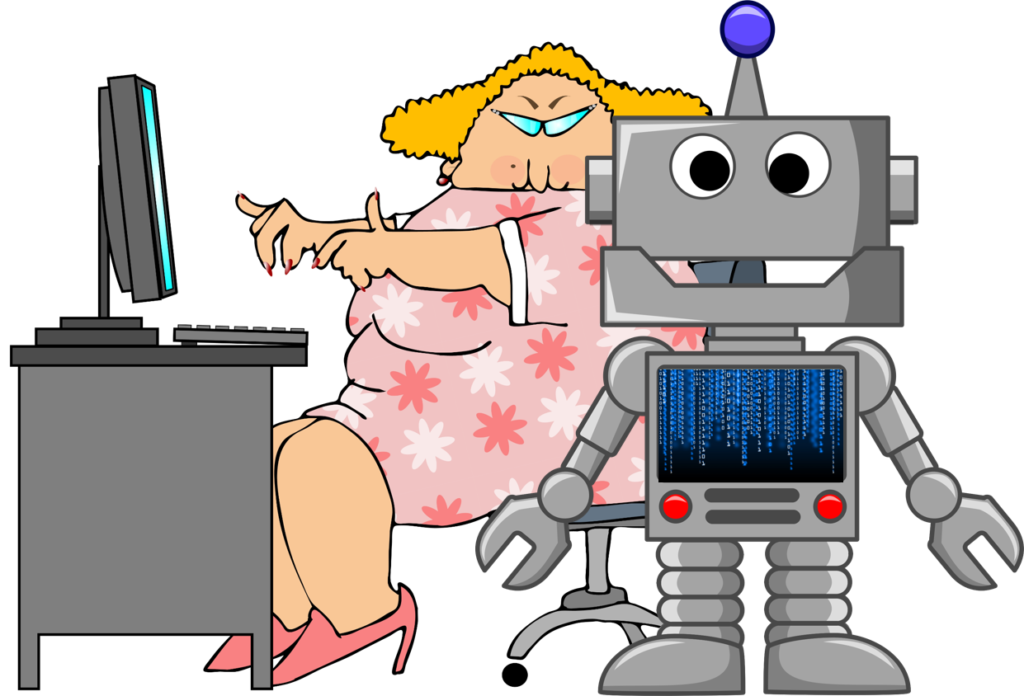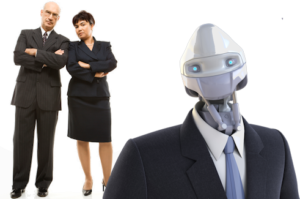There remains a raging debate about whether artificial intelligence (AI), in the years ahead, is going to create mass, global unemployment resulting in social unrest, chaos, and the collapse of the global economic system. Author Alex Salkever (@AlexSalkever) writes, “The general consensus on whether robots will take jobs wholesale remains mixed but is trending towards resignation. The optimists believe that, as with the Industrial Revolution and the Agricultural Revolution, the technological improvements that will come from the dawning era of artificial intelligence and its offshoot in modern robotics will create more new jobs than they destroy. But until now, those conversations have held that the robots and AI will replace human jobs at some point in the future.”[1] Contrary to what Salkever writes, I’m reading an increasing number of articles that conclude AI and robotics aren’t likely to replace human workers but are more likely to become their co-workers. Jason Bloomberg (@TheEbizWizard), an IT industry analyst, explains, “While AI is certainly improving and extending the capabilities of such automation, much of its focus is on individual tasks, rather than roles.”[2] Kevin Kelly (@kevin2kelly), founding Executive Editor of Wired magazine, adds, “This is not a race against the machines. If we race against them, we lose. This is a race with the machines.”[3]
No time to relax
Although predictions about job losses and job creation are mixed, a recent Gartner study concluded, “AI will create 2.3 million jobs in 2020, while eliminating 1.8 million.”[4] Don’t get too excited. That prediction is very short range and Svetlana Sicular (@Sve_Sic), a research vice president at Gartner, cautions, “Unfortunately, most calamitous warnings of job losses confuse AI with automation — that overshadows the greatest AI benefit — AI augmentation — a combination of human and artificial intelligence, where both complement each other.” Edgar Dias, Managing Director of ServiceNow India, writes, “Like each wave of innovation brings fear of job reduction, the fear that AI will make human effort redundant is rising. This leads to the question — ‘Is the goal to eliminate jobs or to enhance the quality of jobs?’ … AI in collaboration with people will shape the future of work. With AI, there will be a future in which automation and service intelligence handle routine tasks so that people can focus on the creative, meaningful work that attracted them to their fields in the first place. The purpose of AI will be largely to increase productivity and innovation. In the ‘workplace of the future’, tasks will be assigned basis the collaboration of the ability of humans and non-humans.[5]
Deloitte analysts note, “Robotics, cognitive, artificial intelligence, and other ‘smart’ solutions are increasingly providing the means to automate certain low-level workplace tasks. This could empower human workers to focus on aspects of their jobs that require strategic thinking, social savvy, or emotional intelligence, among other skills. … Rather than displace human workers, bots and other intelligent automation solutions are providing a foundation for human-machine collaboration.”[6] Just because the most likely future is one in which humans and machines work side-by-side, we humans should not breathe easy. The truth of the matter is job displacements and redundancies are going to take place even if more jobs are created than lost. Workers not made redundant will discover co-worker smart machines dramatically change the jobs they fill and the skills they need to succeed. Will the next few decades be disruptive? Probably. Bloomberg asserts, “Of all the technologies that drive digital transformation in the enterprise, people often tout artificial intelligence as perhaps the most disruptive of all.” To help mitigate this disruption, all stakeholders from employees to employers to academics to policy-makers must play a role.
Preparing for the future of work
At the Dell Technology World conference, John Roese (@theICToptimist), CTO of Dell Technologies, told participants machine learning and artificial intelligence represent one of the biggest disruptions to their career.[7] For mid-career workers and people yet to join the workforce, the skills they will need to succeed in the future are likely to change. Mike Volpi (@mavolpi), a General Partner at Index Ventures, notes, “Retraining programs for displaced workers will undoubtedly be critical. Whether it’s globalization or AI, we need to assist people in transforming their professional skills to what the market needs. We should remember that many of the jobs we do today didn’t exist 20 years ago. So although automation will mean that some jobs disappear, new ones will be created too. We will need reliable and thoughtful mechanisms to connect workers with those new opportunities — marketplaces for labor and services that allow the monetization of specific skills, and there’s more opportunity there.”[8] R. Edward Freeman (@RE_Freeman) and James R. Freeland, professors at the Darden School of Business at the University of Virginia, agree with Volpi. They observe, “Whatever the net increase or decrease in jobs overall, what is not at issue is that these will be different jobs, requiring different skill sets.”[9]
When it comes to skills required for future work success, two questions come to mind: What are those skills? Who provides the training for those skills? As regards to the first question, Guthrie Jensen, a global training consultancy, suggests ten skills future workers are likely to require.[10] They are:
- Complex problem solving. “The skill to see relationships between industries and craft creative solutions to problems that are yet to appear.”
- Critical thinking. The skill to turn “data into insightful interpretations.”
- Creativity. The skill to harness “the quality of randomness and the ability to build something out of ideas.”
- People management. The skill to lead and manage people.
- Coordinating with others. The skill to communicate effectively and foster team collaboration.
- Emotional intelligence. A keen curiosity complemented by the ability to be empathetic.
- Judgment and decision-making. “The ability to condense vast amounts of data, with the help of data analytics, into insightful interpretations and measured decisions.”
- Service orientation. The ability to offer “value to clients in the form of services and assistance.”
- Negotiation. “The ability to negotiate with businesses and individuals to come up with a win-win situation.”
- Cognitive flexibility. “The ability to switch between different personas to accommodate the challenge at hand.”
In addition to those soft skills, people will need specific hard skills in order to adapt to the future workplace. Those skills will often be unique to the industries in which they work. As for the second question — Who provides the training for those skills? — the educational sector will certainly play a role; but, employers also have a role to play. On that front, some employers are not measuring up. Valerie Bolden-Barrett reports, “More than half the respondents in a new study think employers aren’t preparing workers for future tech jobs, according to a nationwide consumer survey by Researchscape for Coding Dojo, a firm specializing in programming literacy. And even more respondents (90%) think employers — not workers — are mainly responsible for upskilling staff.”[11] She also notes not everyone believes the challenge falls mostly on the shoulders of employers. “By contrast,” she writes, “80% of workers in a 2017 Randstad U.S. survey said upskilling was their own responsibility, but neither they nor their employers were taking any action.”
Summary
In the years ahead, employers and employees failing to ensure the skills needed are available as jobs morph in response to automation will likely be losers in the business world. MIT’s Erik Brynjolfsson (@erikbryn) insists, “Racing with the machine beats racing against the machine. Technology is not destiny. We shape our destiny.”[12]
Footnotes
[1] Alex Salkever, “What if A.I. is coming for jobs faster than we thought?” Big Think, 10 August 2018.
[2] Jason Bloomberg, “Think You Know How Disruptive Artificial Intelligence Is? Think Again,” Forbes, 7 July 2018.
[3] Kevin Kelly, “The Seven Stages of Robot Replacement,” Backchannel, 27 December 2016.
[4] Rob van der Meulen and Christy Pettey, “Gartner Says By 2020, Artificial Intelligence Will Create More Jobs Than It Eliminates,” Gartner Newsroom, 13 December 2017.
[5] Edgar Dias, “Artificial Intelligence – An enabler of jobs of the future,” Moneycontrol, 30 July 2018.
[6] Deloitte, “Workers and Bots, Unite!” The Wall Street Journal, 10 August 2018.
[7] Maribel Lopez, “Machine Learning And AI Will Disrupt All Careers According To Dell’s Roese,” Forbes, 2 August 2018.
[8] Mike Volpi, “How We Can Prepare For Artificial Intelligence Job Displacement,” Forbes, 28 June 2018.
[9] Edward Freeman and James R. Freeland, “The Time for Retraining Is Now,” MIT Sloan Management Review, 6 April 2018.
[10] Staff, “Skills of the Future – 10 Skills You’ll Need to Thrive in 2020 Infographic,” Insights: The Guthrie-Jensen Blog, 2018.
[11] Valerie Bolden-Barrett, “Employers aren’t preparing workers for future tech roles, survey says,” CIO Dive, 1 August 2018.
[12] Paul Martin, “How to: Survive the Job Automation Apocalypse,” LinkedIn, 6 August 2015.





